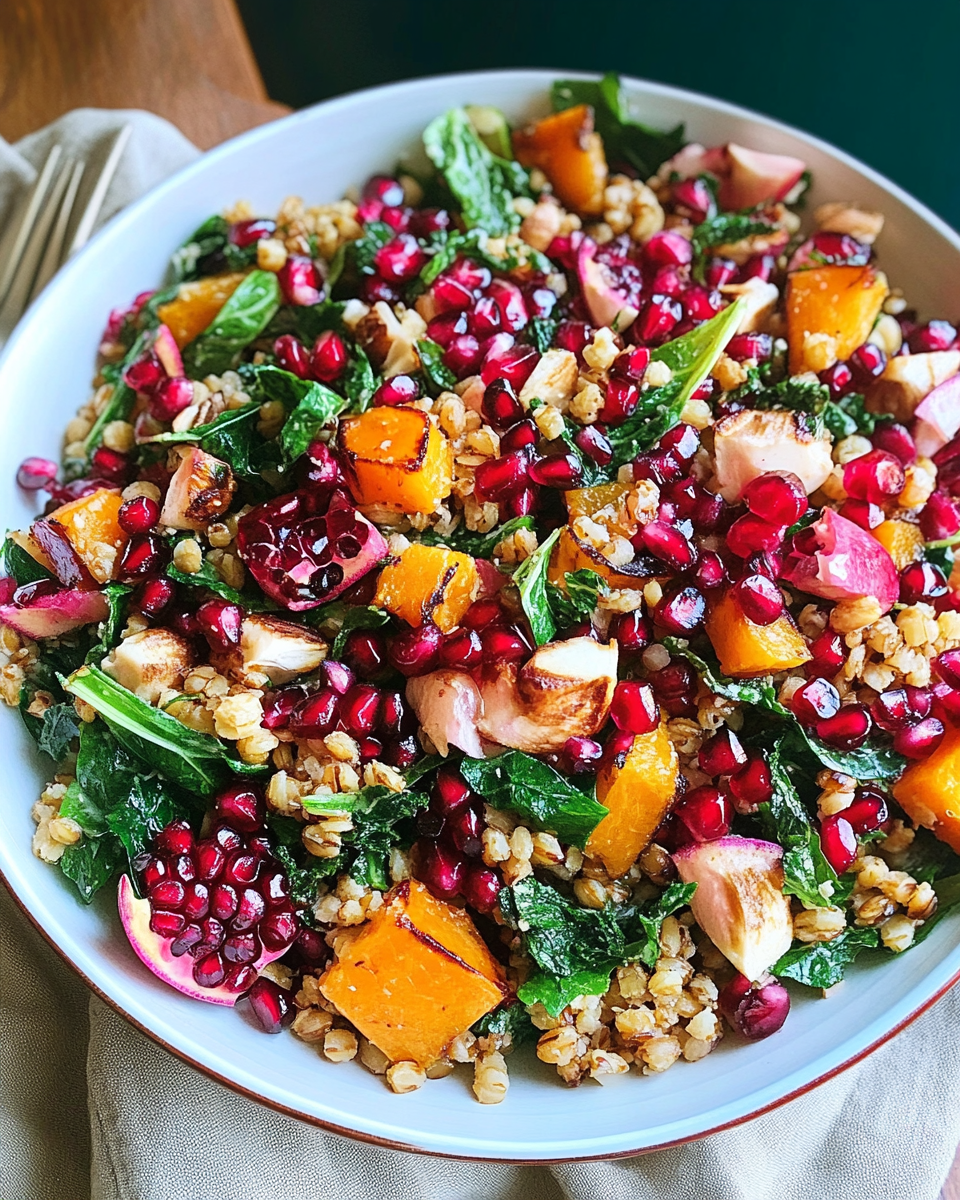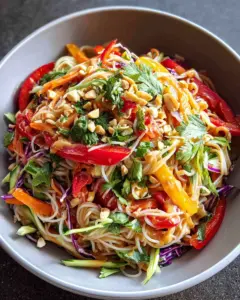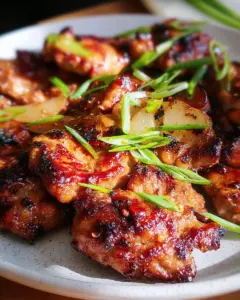When the weather turns cold, salads often take a backseat to hearty stews and roasted dishes. But this winter pomegranate and grain salad defies expectations—it’s robust, flavorful, and packed with seasonal ingredients that make it a standout dish. Combining roasted butternut squash, nutty farro, crisp kale, and ruby-red pomegranate arils, it’s a celebration of textures and colors. The tangy-sweet dressing, made with maple syrup, miso, and Dijon mustard, ties everything together with a balance of umami and brightness. Whether you’re serving it as a holiday side, a meal-prep lunch, or a light dinner, this salad is as nourishing as it is delicious.

Essential Tools and Equipment
Before diving into the recipe, gather these key tools to streamline your prep:
- Baking sheet: For roasting the butternut squash evenly. A rimmed sheet prevents spills and promotes caramelization.
- Instant Pot or saucepan: Farro cooks faster in an Instant Pot (7 minutes under pressure), but a saucepan works too—just simmer for 25–30 minutes.
- Mixing bowls: Use one for dressing and another to massage the kale. Glass or stainless steel bowls are ideal for easy cleanup.
- Sharp chef’s knife: Crucial for cubing squash and finely chopping kale. A dull knife makes prep tedious and unsafe.
- Measuring spoons and cups: Precision matters for the dressing’s sweet-tangy balance.
Preparation Tips for Success
- Roast the squash ahead: Cubed butternut squash can be roasted 1–2 days in advance. Store it refrigerated in an airtight container, then reheat in an air fryer (350°F for 5 minutes) to restore crispness.
- Massage the kale: Ripping the leaves from tough stems and massaging them with a bit of dressing softens their texture and reduces bitterness.
- Deseed pomegranates effortlessly: Slice the fruit in half, submerge it in a bowl of water, and gently pry out the arils. The pith floats, making cleanup a breeze.
Ingredients Breakdown
For the Salad Base:
- Farro: This ancient grain adds chewiness and fiber. For gluten-free versions, swap in quinoa or millet.
- Butternut squash: Roasting concentrates its natural sweetness. Swap with sweet potatoes or beets if preferred.
- Kale: Dino (lacinato) kale holds up better than curly varieties when dressed.
- Pomegranate arils: Bursting with juice, they add a festive pop. No fresh pomegranate? Dried cranberries work in a pinch.
- Radicchio (optional): Its bitter notes contrast the sweetness of squash and pomegranate.
For the Dressing:
- Olive oil: Use extra-virgin for fruity depth.
- Apple cider vinegar: Adds tang; white wine vinegar or lemon juice are substitutes.
- Soy sauce: Provides umami. For gluten-free, use tamari or coconut aminos.
- Maple syrup: Balances acidity. Honey works but isn’t vegan.
- Dijon mustard: Emulsifies the dressing and adds sharpness.
- Miso: White or yellow miso lends complexity. Omit if unavailable, but add a pinch of salt.
Step-by-Step Instructions
Roast the Butternut Squash
Preheat the oven to 375°F. Peel the squash, cut it into 1-inch cubes, and toss with 1 tablespoon olive oil and ½ teaspoon salt. Spread on a baking sheet in a single layer. Roast for 25–30 minutes, flipping halfway, until edges caramelize. Let cool slightly—this helps crisp the exterior.
Cook the Farro
Rinse 1 cup farro under cold water. For the Instant Pot, add farro and 2 cups broth or water. Pressure-cook for 7 minutes, then let the pressure release naturally for 7 more minutes. Drain excess liquid. For stovetop, simmer in 3 cups water for 25–30 minutes until tender but chewy.
Prep the Pomegranate
Slice the pomegranate horizontally. Hold each half over a bowl of water and gently break apart the arils with your fingers. Discard the floating pith and drain the seeds.
Make the Dressing
In a small bowl, whisk together 4 tablespoons olive oil, 1 tablespoon apple cider vinegar, 1 tablespoon soy sauce, 1 tablespoon maple syrup, 1–2 teaspoons Dijon mustard, and 1 tablespoon miso. Season with black pepper. Taste and adjust—add more syrup for sweetness or vinegar for tang.
Assemble the Salad
In a large bowl, combine the chopped kale with 1–2 tablespoons dressing. Massage for 1–2 minutes until the leaves darken and soften. Add cooked farro, roasted squash, pomegranate arils, and chopped radicchio (if using). Toss gently. Serve with extra dressing on the side.
Pro Tip: For meal prep, store components separately. The dressed kale will keep for 3 days, while roasted squash and farro last up to 5 days refrigerated.
This vibrant salad shines as both a standalone meal and an impressive side dish. Its versatility makes it perfect for everything from weeknight dinners to holiday feasts. Here’s how to serve it at its best while avoiding common pitfalls that could dull its flavors or textures.
Ideal Serving Suggestions
The salad’s balance of hearty grains, roasted vegetables, and bright dressing lends itself to numerous serving styles:
- Family-style presentation: Pile the salad high on a large platter, allowing the jewel-toned pomegranate arils and orange squash cubes to create visual appeal. Drizzle extra dressing over the top just before serving to prevent sogginess.
- Meal-prep containers: For packed lunches, layer ingredients in mason jars starting with dressing at the bottom, followed by farro, squash, kale, and pomegranate. Shake to mix when ready to eat.
- Holiday buffet staple: Serve in a decorative bowl alongside other seasonal dishes. The salad’s colors complement traditional winter spreads beautifully.
- Protein boost: Top individual portions with grilled chicken, seared salmon, or crispy chickpeas to transform it into a complete meal.
Temperature Considerations
This salad adapts well to different serving temperatures:
- Room temperature: Ideal for most occasions, allowing all flavors to shine. Remove from refrigeration 15 minutes before serving if pre-made.
- Slightly warm: Reheat the farro and squash briefly (5 minutes in a 300°F oven) before combining with other ingredients for a comforting winter dish.
- Chilled: Works well for packed lunches, though the kale may become slightly more fibrous when cold.
8 Perfect Side Dish Pairings
While substantial on its own, these accompaniments create balanced meals:
- Creamy soups: Butternut squash or mushroom bisque contrast the salad’s textures.
- Crusty artisan bread: Ideal for soaking up extra dressing. Try walnut or sourdough varieties.
- Roasted Brussels sprouts: Tossed with balsamic glaze for complementary caramelized notes.
- Citrus-marinated olives: Their briny flavor cuts through the salad’s richness.
- Herbed quinoa: Adds another nutritious grain option to the spread.
- Baked brie: The creamy cheese pairs wonderfully with pomegranate’s tartness.
- Spiced nuts: Candied pecans or chili-lime almonds provide crunch.
- Apple-walnut slaw: Offers a refreshing, crisp contrast.
Common Mistakes and How to Avoid Them
Even simple salads can go awry. Here are frequent missteps and professional solutions:
1. Soggy greens
- Cause: Dressing the kale too far in advance or using excess dressing.
- Fix: Massage kale with just 1-2 tablespoons dressing right before serving. Store leftover dressed salad for no more than 8 hours.
2. Mushy farro
- Cause: Overcooking or failing to drain properly.
- Fix: Cook until al dente (about 7 minutes pressure-cooked or 25 minutes simmered). Drain thoroughly in a fine-mesh sieve.
3. Burnt squash
- Cause: Uneven cubing or overcrowded pan.
- Fix: Cut uniform 1-inch pieces and roast in a single layer on a preheated sheet.
4. Dressing separation
- Cause: Improper emulsification.
- Fix: Whisk dressing vigorously or shake in a jar. Add mustard to stabilize.
5. Bitter aftertaste
- Cause: Overusing radicchio or old kale.
- Fix: Balance bitter elements with extra maple syrup in dressing or omit radicchio.
Pro Techniques for Flavor Enhancement
Take your salad from good to exceptional with these chef-approved methods:
- Toast the farro: Before cooking, dry-toast grains in a skillet for 3-4 minutes to enhance nuttiness.
- Infuse the oil: Warm olive oil with rosemary or garlic before making dressing for deeper flavor.
- Salt in layers: Season squash before roasting, farro while cooking, and greens during assembly.
- Acid adjustment: Brighten leftovers with a fresh squeeze of lemon juice before serving.
Presentation Tips for Special Occasions
Impress guests with these aesthetic touches:
- Garnish strategically: Sprinkle pomegranate arils and chopped herbs (parsley, chives) over the top for color contrast.
- Edible flowers: Nasturtiums or pansies add elegance to holiday servings.
- Serving vessels: Hollowed-out pomegranate halves or small squash shells make memorable natural bowls.
- Texture contrast: Add toppings like toasted pepitas or fried shallots at the table for crunch.
Dietary Adaptations
The recipe easily accommodates various dietary needs:
- Gluten-free: Substitute farro with quinoa or certified GF oats.
- Nut-free: Replace nuts with sunflower or pumpkin seeds.
- Lower-carb: Reduce farro by half and add roasted cauliflower.
- Dairy enhancement: Crumble goat cheese or feta over individual servings.
No seasonal dish is complete without knowing how to store leftovers properly and revive them for later enjoyment. This final section covers essential storage methods, answers to common questions, and professional tips to ensure your winter pomegranate and grain salad remains fresh and flavorful.
Optimal Storage Methods
Proper storage keeps the salad’s textures intact and prevents sogginess. Follow these guidelines for best results:
Refrigerator Storage
- Undressed salad: Store components separately in airtight containers for up to 4 days.
- Farro: Keeps well for 5 days; add a splash of water when reheating to restore moisture.
- Roasted squash: Place in a single layer to prevent steaming and maintain crispness.
- Kale and pomegranate arils: Store together but avoid dressing until serving.
- Assembled salad (dressed): Consume within 8–12 hours, as kale wilts and pomegranate bleeds color.
Freezing Considerations
- Not recommended: Freezing alters the texture of kale and pomegranate, making them mushy.
- Partial freezing: Only freeze cooked farro and roasted squash (up to 1 month). Thaw overnight in the fridge before use.
Reviving Leftovers
- Air fryer method: Reheat squash at 350°F for 3–5 minutes to restore crispness.
- Room-temperature serving: Let refrigerated salad sit for 10 minutes before eating to soften kale.
- Dressing refresh: Add a squeeze of lemon or a teaspoon of vinegar to brighten flavors.
Recipe Variations and Customizations
Adapt the salad to suit preferences or pantry staples:
Grain Swaps
- Quinoa: Cooks faster and adds protein (use 1:2 quinoa-to-water ratio).
- Barley: Chewier texture; soak overnight to reduce cooking time.
- Wild rice blend: Adds earthy depth (simmer for 45 minutes).
Vegetable Alternatives
- Roasted sweet potatoes: Swap for butternut squash; toss with smoked paprika for depth.
- Shredded Brussels sprouts: Replace kale for a crunchier base.
- Beets: Roast with squash for vibrant color and sweetness.
Dressing Twists
- Creamy version: Blend 2 tbsp tahini or Greek yogurt into the original dressing.
- Citrusy option: Replace apple cider vinegar with orange or grapefruit juice.
- Spicy kick: Add ½ tsp harissa or red pepper flakes.
Protein Additions
- Plant-based: Toss with chickpeas or lentils.
- Animal proteins: Top with grilled shrimp, salmon, or shredded chicken.
Frequently Asked Questions (FAQs)
1. Can I make this salad ahead for a party?
Yes, but prep components separately and assemble 1 hour before serving. Dress just before eating.
2. How do I prevent pomegranate arils from sinking to the bottom?
Toss them lightly with cooked farro before adding other ingredients—the grains act as anchors.
3. My dressing tastes too salty. How can I fix it?
Balance with 1 tsp honey or maple syrup and ½ tbsp lemon juice. Dilute with 1 tbsp water if needed.
4. Can I use frozen butternut squash?
Yes, but thaw and pat dry before roasting to avoid excess moisture.
5. Why is my kale tough even after massaging?
Remove the stems completely and chop finely. Massage with ½ tsp salt before adding dressing to break down fibers.
6. How can I make this salad more filling?
Add ⅓ cup toasted nuts (walnuts, almonds) or avocado slices for healthy fats.
Nutritional Benefits and Seasonal Appeal
This salad isn’t just delicious—it’s packed with nutrients:
- Pomegranate arils: High in antioxidants and vitamin C.
- Kale: Rich in vitamins A, K, and fiber.
- Farro: Provides plant-based protein and iron.
- Butternut squash: Loaded with beta-carotene.
Its seasonal ingredients make it a winter standout, but the recipe adapts year-round:
- Spring: Add shaved asparagus or peas.
- Summer: Mix in grilled zucchini or corn.
- Fall: Top with roasted apples or cranberries.
Final Tips for Success
- Toast your grains: Dry-toast farro in a skillet before boiling for nuttier flavor.
- Double the dressing: Use leftovers on roasted vegetables or grain bowls.
- Layer textures: Add crispy elements (like fried shallots) just before serving.
- Season in stages: Salt squash before roasting, farro while cooking, and greens during assembly.
This winter pomegranate and grain salad is more than a recipe—it’s a versatile template for seasonal eating. With proper storage, smart adaptations, and attention to texture, it will become a cold-weather staple.
Winter Pomegranate and Grain Salad
Ingredients
For the Salad:
- 1 cup organic farro rinsed and cooked (see instructions for cooking tips)
- 1 whole butternut squash peeled and cut into 1-inch cubes (roasted ahead of time; air fry to reheat if serving the next day)
- 2 bunches organic dino kale washed, de-stemmed, and finely chopped
- 1 whole pomegranate arils removed
- 1 small radicchio finely chopped (optional)
- 1 green onion finely chopped (green and white parts, optional)
For the Dressing:
- 4 tablespoons olive oil
- 1 tablespoon apple cider vinegar
- 1 tablespoon soy sauce
- 1 tablespoon maple syrup
- 1 –2 teaspoons Dijon mustard
- 1 tablespoon miso
- Salt and pepper to taste
Instructions
Roast the Butternut Squash:
- Preheat the oven to 375°F. Peel and cube the butternut squash into 1-inch pieces. Spread them on a baking sheet, drizzle with olive oil, and sprinkle with salt. Roast for 25–30 minutes, flipping halfway through. Let the squash sit on the pan after roasting to crisp up.
Cook the Farro:
- Cook farro according to the package instructions. For faster cooking, use an Instant Pot: combine farro with a 2:1 ratio of liquid (e.g., bone broth) and cook on pressure for 7 minutes, then let sit for another 7 minutes. Drain excess liquid if necessary. You may not need all the cooked farro for the salad.
Prepare the Pomegranate Arils:
- Cut the pomegranate in half and place it in a bowl of water. Gently separate the seeds from the white pith, which will float to the top. Scoop out the pith, then drain and set aside the arils.
Make the Dressing:
- In a small bowl, whisk together the olive oil, apple cider vinegar, soy sauce, maple syrup, Dijon mustard, and miso. Add salt and pepper to taste. Adjust seasoning as needed.
Prepare the Kale:
- Wash, de-stem, and finely chop the kale. Massage 1–2 tablespoons of the dressing into the kale to soften it before assembling the salad.
Assemble the Salad:
- In a large bowl, combine the massaged kale with the radicchio and green onion (if using). Top with cooked farro, roasted butternut squash, and pomegranate arils. Serve with the remaining dressing on the side or drizzle over individual servings.
- Notes
- Make-Ahead Tips: Roast the squash, cook the farro, and prep the pomegranate arils in advance for quick assembly. Air fry the butternut squash when reheating.
- Dressing: Double the dressing recipe to use for other salads throughout the week.
Variations:
- Grains: Swap farro for quinoa, barley, or couscous.
- Veggies: Add roasted sweet potatoes or beets for extra color.
- Nuts/Seeds: Top with toasted walnuts, almonds, or pumpkin seeds for added crunch.
- Cheese: For a non-vegan option, crumble feta or goat cheese over the salad.






